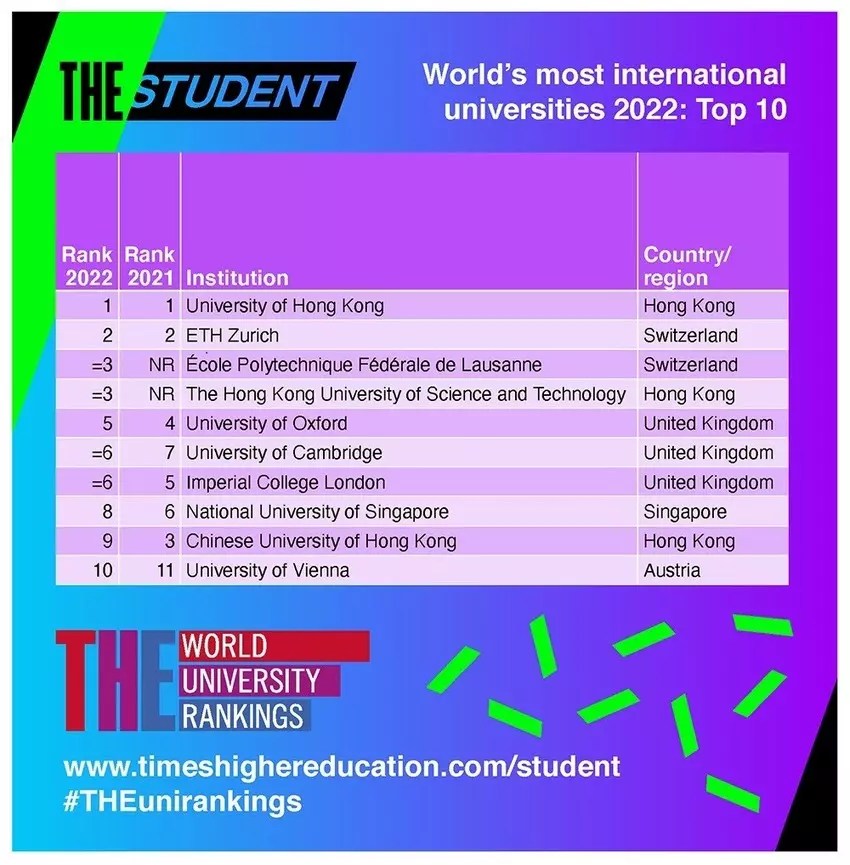These are the most international universities in the world in 2022

- Times Higher Education’s (THE) survey of over 10,000 academics features internationally oriented universities leading global academic collaboration efforts through knowledge diplomacy.
- Knowledge diplomacy values scientific exchange and diverse, international student bodies and research teams.
- Universities in politically insular countries are increasingly working with research partners from around the world.
While the diplomatic world faces many challenges on the political front, knowledge diplomacy, led by many top international universities, “may be our last and best tool for rebuilding a broken world”.
This was the stirring message of Safwan Masri, Executive Vice-President for global development at Columbia University at a keynote speech at Times Higher Education’s MENA Universities Summit in 2021.
Masri lamented that much of the world is grappling with misunderstanding, division, polarization and cynicism. He adds that “We are living in profoundly undiplomatic times. The inability to understand and comprehend one another is turning neighbor against neighbor. Everything seems broken.”
For Masri and other delegates at the THE summit, global research universities are a shining light in difficult times, with Masri stating that: “Universities exist to increase our comprehension of the world and to enhance mutual understanding”.
The COVID-19 pandemic has exemplified the role of universities in addressing major challenges. Through medical schools, at research institutions, in laboratories, and at public health agencies worldwide, the role of universities has been critical in fighting the virus. Masri points out that “The vaccines’ designs are built on decades worth of work from tens of thousands of researchers, crisscrossing the globe between universities, industries and governments”.
In the spirit of Masri’s powerful vision for knowledge diplomacy and the World Economic Forum’s rallying call for Davos Agenda to work together and restore trust, THE published its 2022 ranking of the world’s most international universities on 19 January 2022. This ranking focusses on the universities that are most connected across borders. These have revered international reputations, have the highest proportion of international students and staff, and have the most research published in collaboration with global partners. The survey is based on input from over 10,000 academics worldwide.
Top 10 international universities in the world 2022
The ranking is encouragingly diverse, with the top 10 featuring representation from five regions.

International trade and innovation hubs are home to the most international universities
Thriving international trade and innovation hubs dominate the list, with the University of Hong Kong taking first place. Its neighbours, the Hong Kong University of Science and Technology (joint third) and Chinese University Hong Kong (ninth) also make the top 10. These institutions contribute enormously to the growth of technology innovation and the knowledge economy in the Greater Bay Area megalopolis (which includes Shenzhen and Macau).’
Singapore is, alongside Hong Kong, East Asia’s leading innovation and knowledge hub. The National University of Singapore exemplifies this, bagging eighth place. It has long had a sterling reputation for its role as a magnet for international academic talent and global partnerships.
In Europe, Switzerland’s ETH Zurich and EPFL take second and joint third place. The UK stays fully connected to global talent, with Oxford University taking fifth place. Cambridge University and Imperial College London, meanwhile, share sixth.
Alice Gast, the president of Imperial College London, has likened the importance of global cooperation in higher education to “hybrid vigour” in botany. “As you build a team,” she says, “you bring together diverse people that provide effective views. Individuals brought up in different education systems are exposed to unique methods and approach problems differently. International teams broaden and augment individual thinking.” Such global teams, united under shared goals, are vital to address global challenges such as pandemics, climate change and food security.
Oxford University developed its hugely successful COVID-19-vaccine with AstraZeneca, in record time. Here, almost half of all staff, and 40% of students, are from outside the UK. With Oxford’s vaccine already injected into more than a billion arms worldwide, this work, for Masri, is the perfect encapsulation of the power of knowledge diplomacy: “The COVID vaccine represents decades’ worth, perhaps even centuries’ worth, of university-generated knowledge – all concentrated in a single shot that will reconnect the people of the world.”
Universities around the world are increasingly interconnected and collaborating in research
Times Higher Education’s analysis from the 2022 edition of the world’s most international universities list shows that universities in more isolated nations, including countries like Russia and mainland China, are increasing their global collaboration and outreach programs. Data shows that the proportion of internationally collaborative research is growing worldwide.
Scopus reports that, on their database, in 2010, only 14% of Chinese research was published with international collaboration. This figure grew to 23% by 2020. So too, South Korea’s international research collaboration efforts grew from 25% of output in 2010 to 31% in 2020. The UK’s share rocketed from 40% to 59% in the same period, while, globally, the share of global research that involves international collaboration grew from 16% to 22%.
Republished with permission of the World Economic Forum. Read the original article.





